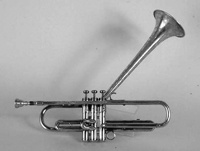

Percy Humphrey Dizzy Gillespie's Trumpet
BATON ROUGE, La.—In the culture and history of Louisiana, Napoleon and Louis Armstrong mixed with shrimpers and costume-clad Mardi Gras revelers to shape the state. The mighty Mississippi River and colorful politicians determined much of its course.
Theoriginalityand intrigues weren't lost on the crafters of the new $23 millionLouisianaState Museum, a 69,000-square-foot metallic building showcasing a treasure trove of state artifacts and oddities.
"It was important to look at the entire state's culture from music, food, our role in the civil rights movement and all of the other pieces that make up the complete fabric of Louisiana," said Carma Fauntleroy, the museum's interim director.
Themuseum,which opened Feb. 1 after nearly a yearlong delay, presentsthe state's history through a thematic tour rather than a chronological approach.
Insidethe main floor, a plasterdeath maskof Napoleon, made when he died in 1821, rests behind oval glass in the area depicting the $15 million Louisiana Purchase, when France sold the Louisiana territory to the United States in 1803.
A hulking, black iron Confederate submarine found in Lake Pontchartrain casts its shadow on cases documenting Louisiana's role in several wars.
A Black history exhibit includes the brooms and shears used by slave laborers and the heavy wood and metal door that once locked slaves into a jail at the Fairview Plantation in New Orleans. There is also a display on the 1953 Baton Rouge Bus Boycott, which became a prototype for the Montgomery Bus Boycott in Alabama later during the civil rights movement.
Earl Hebert's attention, however, was fixed on a huge, 45-foot aqua and white shrimp trawler, made of cypress and Spanish cedar, named the Coca-J. Hebert, visiting the museum with his family as part of a preview event, was captain of the boat from 1992 through 2004, named it after his two children and sold it to the museum when it became too tough to make a living as a Louisiana shrimper.
"It's an honor to know it's going to be here for life, and my children and hopefullymy grandchildren can come look at it," said Hebert, who now works on tugboats.
But as he continued to describe the time spent with his wife and children on the Coca-J, he added, "It's hard to come here and see something you loved so much and spent your life on."
In a nearby display, one of Louis Armstrong's trumpets and his slightly tarnished slide cornet rests in a section of the museum dedicated to two "Louisiana Giants." The other is Huey Long, the populist former governor and senator who was assassinated in the state Capitol that he built and which looms across the street from the new museum.
Long's tuxedo and original headstone are on view for visitors, along with film clips of his famous stump speeches, delivered with arms flailing.
Upstairs, a Louisiana State University tailgating display and a bonfire like the type lit in St. James Parish to welcome Papa Noel on Christmas Eve depict southeastern Louisiana life.
And near the giant crawfish, with a divider made of plastic silver beads, Mardi Gras comes to life. The costumes of kings, queens and maids of parade krewes from years past are on display, along with the head of one of New Orleans' famous floats.
For the music lover, the museum includes artifacts celebrating Louisiana's links to jazz, blues, zydeco, swamp pop and country, including a guitar and overalls from bluesman Buddy Guy and the fiddle on which Cajun legend Michael Doucet learned to play in Lafayette.










